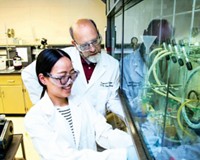Advertisement
Grab your lab coat. Let's get started
Welcome!
Welcome!
Create an account below to get 6 C&EN articles per month, receive newsletters and more - all free.
It seems this is your first time logging in online. Please enter the following information to continue.
As an ACS member you automatically get access to this site. All we need is few more details to create your reading experience.
Not you? Sign in with a different account.
Not you? Sign in with a different account.
ERROR 1
ERROR 1
ERROR 2
ERROR 2
ERROR 2
ERROR 2
ERROR 2
Password and Confirm password must match.
If you have an ACS member number, please enter it here so we can link this account to your membership. (optional)
ERROR 2
ACS values your privacy. By submitting your information, you are gaining access to C&EN and subscribing to our weekly newsletter. We use the information you provide to make your reading experience better, and we will never sell your data to third party members.
“Assessing Safety” presents the results of a survey of academic chemistry departments on safety training and evaluation and concludes that the results are somewhat confusing, albeit generally positive (C&EN, June 21, page 33). I quite agree that the results are confusing, but mainly because the term “safety training” is undefined.
In my experience, institutional safety training sessions for students and faculty provide little useful safety-related information. They concentrate on matters of legislation and reporting that relate more to the safety of the institution from legal challenge than to the safety of workers in laboratories. The one thing they never cover is specific techniques and practices needed to work safely with reagents and solvents in a research laboratory. The bottom line in lab safety is knowing what the hazards might be and how to avoid them, not the legally mandated format for a workplace label on a solvent bottle.
Academic departments will have a culture of safety if research faculty teach students the correct way to think and work in the laboratory. Training sessions of the kind that I have seen at every institution I have been associated with only convey a culture of “cover your a--.” Research faculty have to take ownership of safety training. Laboratory safety is far too important to leave to the lawyers and bureaucrats.
Philip G. Hultin
Winnipeg, Manitoba
I have read C&EN articles and letters concerning academic and industrial laboratory safety with great interest. However, an area neglected and of great concern to me when I was in both academic and industrial settings was the misuse of gloves.
I saw a chemist or biologist leave the lab with gloves on any number of times. Gloves are worn in the lab to protect the wearer from hazards. Wearing gloves outside the lab and touching door handles, elevator buttons, handrails, or instrument controls has the potential to expose countless others to that hazard! My students and colleagues were always told that if both gloves cannot be removed, then remove the glove from the hand that touches anything others will use.
When I came across a scientist with gloves on outside the lab, I always asked them, “Why are you wearing gloves?” The answer was always, “Because I’m working with such-and-such and don’t want it on my hands.” Usually, at this point, there would be a sign of recognition that what they were doing was dangerous.
One could, of course, argue that everyone should wear gloves all the time, but that’s unrealistic. Not everything one does in the lab requires gloves, and visitors and service people come and go from buildings and labs all the time.
Much of being safe, in and outside of the laboratory, is just thinking of the consequences before doing something. Sometimes, however, things need to be pointed out, and proper use of gloves is an issue that is too often neglected.
Louise H. Foley
Old Forge, N.Y.




Join the conversation
Contact the reporter
Submit a Letter to the Editor for publication
Engage with us on Twitter